
Reorganization
-
Small-angle neutron scattering experiments were performed on horse azidometmyoglobin (MbN3) at pressures up to 300 MPa.Other spectroscopic techniques have shown that a reorganization of the secondary structure and of the active site occur in this pressure range. The present measurements, performedusingvarious concentrations ofMbN3, showthat the compactness of the protein is not altered as the value of its radius of gyration remains constant up to 300 MPa.
 7p
7p  research12
research12
 23-04-2013
23-04-2013
 54
54
 3
3
 Download
Download
-
Atomic models of the myosin motor domain with different bound nucleotides have revealed the open and closed con-formationsof the switch2 element [Geeves,M.A.&Holmes, K.C. (1999)Annu. Rev. Biochem.68, 687–728]. The two conformations are in dynamic equilibrium, which is con-trolled by the bound nucleotide. In the present work we attempted to characterize the flexibilityof themotor domain in the open and closed conformations in rabbit skeletal myosin subfragment 1.
 11p
11p  fptmusic
fptmusic
 12-04-2013
12-04-2013
 36
36
 2
2
 Download
Download
-
While the importance of Ca2+ channel activity in axonal path finding is established, the underlying mechanisms are not clear. Here, we show that transient receptor potential vanilloid receptor 1 (TRPV1), a member of the TRP superfamily of nonspecific ion channels, is physically and functionally present at dynamic neuronal extensions, including growth cones.
 13p
13p  galaxyss3
galaxyss3
 21-03-2013
21-03-2013
 47
47
 5
5
 Download
Download
-
In previous studies, we have demonstrated that RhoA⁄B-dependent signal-ing regulates TGFb-induced rapid actin reorganization in Swiss 3T3 fibro-blasts. Here we report that TGFbregulates long-term actin remodeling by increasing the steady-state mRNA levels of the RhoBgene in mouse Swiss 3T3 fibroblasts and human hepatoma HepG2 cells.
 14p
14p  galaxyss3
galaxyss3
 07-03-2013
07-03-2013
 45
45
 4
4
 Download
Download
-
EspB is a multifunctional protein associated with the type III secretion system of enterohaemorrhagic Escherichia coli, and interacts with various biomolecules includinga-catenin in the host cell. The binding of EspB to a-catenin is thought be involved in actin reorganization during bacterial infection, although the precise mechanism of this phenomenon is still unclear.
 8p
8p  vinaphone15
vinaphone15
 28-02-2013
28-02-2013
 29
29
 4
4
 Download
Download
-
Enterohemorrhagic and enteropathogenicEscherichia coliproduce various effector proteins that are directly injected into the host-cell cytosol through the type III secretion system. E. colisecreted protein (Esp)B is one such effector protein, and affects host-cell morphology by reorganizing actin net-works.
 7p
7p  mobifone23
mobifone23
 21-01-2013
21-01-2013
 36
36
 3
3
 Download
Download
-
A variety of microbes manipulate the cytoskeleton of mammalian cells to promote their internalization, motility and⁄or spread. Among such bacte-ria, enteropathogenic Escherichia coliand enterohemorrhagic Escherichia coliare closely related pathogens that adhere to human intestinal cells and reorganize the underlying actin cytoskeleton into ‘pedestals’.
 13p
13p  mobifone23
mobifone23
 21-01-2013
21-01-2013
 41
41
 5
5
 Download
Download
-
The ATP-binding cassette protein A1 (ABCA1) mediates the secretion of cellular-free cholesterol and phospholipids to an extracellular acceptor, apolipoprotein A-I, to form high-density lipoprotein. Because ABCA1 is a key factor in cholesterol homeostasis, elaborate transcriptional and post-transcriptional regulations of ABCA1 have evolved to maintain cholesterol homeostasis.
 14p
14p  cosis54
cosis54
 04-01-2013
04-01-2013
 60
60
 4
4
 Download
Download
-
Tuyển tập báo cáo các nghiên cứu khoa học quốc tế ngành y học dành cho các bạn tham khảo đề tài: In vivo reorganization of the actin cytoskeleton in leaves of Nicotiana tabacum L. transformed with plastin-GFP. Correlation with light-activated chloroplast responses
 14p
14p  panasonic06
panasonic06
 25-12-2011
25-12-2011
 42
42
 4
4
 Download
Download
-
Tuyển tập các báo cáo nghiên cứu về y học được đăng trên tạp chí y học Wertheim cung cấp cho các bạn kiến thức về ngành y đề tài: Functional cooperation of of IL-1b and RGS4 in the brachial plexus avulsion mediated brain reorganization...
 11p
11p  thulanh24
thulanh24
 21-11-2011
21-11-2011
 42
42
 3
3
 Download
Download
-
One of the important new features of the Oracle 11g database is the new DDL locking duration control feature. The ddl_lock_timeout parameter lets you specify the length of time a DDL statement will wait for a DML lock. This feature comes in handy when you want to perform online reorganization, where a DML lock by a user may prevent a DDL operation from succeeding.
 10p
10p  vongsuiphat
vongsuiphat
 04-01-2010
04-01-2010
 124
124
 18
18
 Download
Download
CHỦ ĐỀ BẠN MUỐN TÌM























